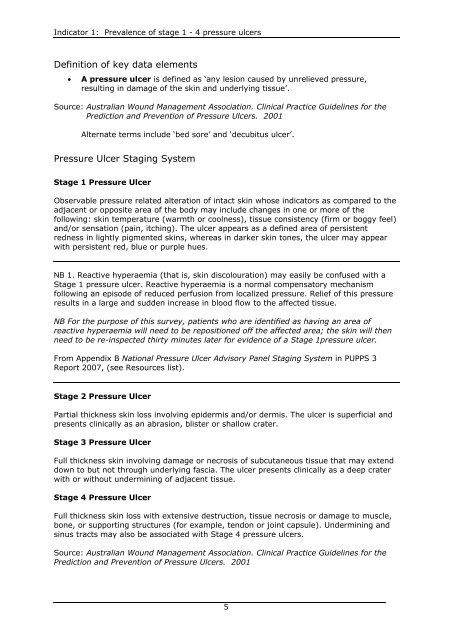Resource Manual For Quality Indicators In - Department of Health
Resource Manual For Quality Indicators In - Department of Health
Resource Manual For Quality Indicators In - Department of Health
You also want an ePaper? Increase the reach of your titles
YUMPU automatically turns print PDFs into web optimized ePapers that Google loves.
<strong>In</strong>dicator 1: Prevalence <strong>of</strong> stage 1 - 4 pressure ulcers<br />
Definition <strong>of</strong> key data elements<br />
• A pressure ulcer is defined as ‘any lesion caused by unrelieved pressure,<br />
resulting in damage <strong>of</strong> the skin and underlying tissue’.<br />
Source: Australian Wound Management Association. Clinical Practice Guidelines for the<br />
Prediction and Prevention <strong>of</strong> Pressure Ulcers. 2001<br />
Alternate terms include ‘bed sore’ and ‘decubitus ulcer’.<br />
Pressure Ulcer Staging System<br />
Stage 1 Pressure Ulcer<br />
Observable pressure related alteration <strong>of</strong> intact skin whose indicators as compared to the<br />
adjacent or opposite area <strong>of</strong> the body may include changes in one or more <strong>of</strong> the<br />
following: skin temperature (warmth or coolness), tissue consistency (firm or boggy feel)<br />
and/or sensation (pain, itching). The ulcer appears as a defined area <strong>of</strong> persistent<br />
redness in lightly pigmented skins, whereas in darker skin tones, the ulcer may appear<br />
with persistent red, blue or purple hues.<br />
NB 1. Reactive hyperaemia (that is, skin discolouration) may easily be confused with a<br />
Stage 1 pressure ulcer. Reactive hyperaemia is a normal compensatory mechanism<br />
following an episode <strong>of</strong> reduced perfusion from localized pressure. Relief <strong>of</strong> this pressure<br />
results in a large and sudden increase in blood flow to the affected tissue.<br />
NB <strong>For</strong> the purpose <strong>of</strong> this survey, patients who are identified as having an area <strong>of</strong><br />
reactive hyperaemia will need to be repositioned <strong>of</strong>f the affected area; the skin will then<br />
need to be re-inspected thirty minutes later for evidence <strong>of</strong> a Stage 1pressure ulcer.<br />
From Appendix B National Pressure Ulcer Advisory Panel Staging System in PUPPS 3<br />
Report 2007, (see <strong>Resource</strong>s list).<br />
Stage 2 Pressure Ulcer<br />
Partial thickness skin loss involving epidermis and/or dermis. The ulcer is superficial and<br />
presents clinically as an abrasion, blister or shallow crater.<br />
Stage 3 Pressure Ulcer<br />
Full thickness skin involving damage or necrosis <strong>of</strong> subcutaneous tissue that may extend<br />
down to but not through underlying fascia. The ulcer presents clinically as a deep crater<br />
with or without undermining <strong>of</strong> adjacent tissue.<br />
Stage 4 Pressure Ulcer<br />
Full thickness skin loss with extensive destruction, tissue necrosis or damage to muscle,<br />
bone, or supporting structures (for example, tendon or joint capsule). Undermining and<br />
sinus tracts may also be associated with Stage 4 pressure ulcers.<br />
Source: Australian Wound Management Association. Clinical Practice Guidelines for the<br />
Prediction and Prevention <strong>of</strong> Pressure Ulcers. 2001<br />
5
















